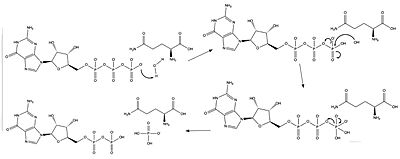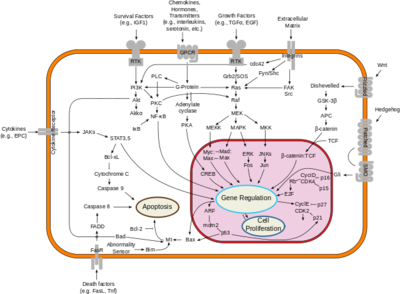Neurofibromin
From Proteopedia
(Difference between revisions)
| Line 5: | Line 5: | ||
===Domains=== | ===Domains=== | ||
==== GRD domain ==== | ==== GRD domain ==== | ||
| + | The Gap-related domain, or GRD, is the catalytic domain of neurofibromin. This domain also contains a tubulin-binding domain. Its main catalytic mechanism is the hydrolysis of GTP-bound Ras into GDP-bound Ras, which converts Ras from its active form into its inactive form. The GRD provides an arginine residue, known as the arginine finger, to Ras. | ||
==== SEC-PH ==== | ==== SEC-PH ==== | ||
| + | The Sec-PH domain is the lipid-binding domain of neurofibromin. In the closed conformation of neurofibromin, the hydrophobic core is blocked by the Gap-related domain. The open conformation allows the hydrophobic core in the Sec cavity to be accessible and exposed. | ||
==== CSRD and CTD ==== | ==== CSRD and CTD ==== | ||
| + | The Cysteine-Serine-rich domain (CSRD) and C-terminal domain (CTD) contain phosphorylation sites. The CSRD is able to be phosphorylated by protein kinases A and C. Phosphorylation by protein kinase C is a positive regulator of neurofibromin activity. The CTD is phosphorylated primarily by protein kinase C. This domain is a negative regulator of neurofibromin activity if particular residues are phosphorylated. It also plays an important role in tubulin binding, as it helps in the transition from metaphase to anaphase. CTD contains a nuclear localization signal as well. | ||
===Important Structural Features=== | ===Important Structural Features=== | ||
====Active Site==== | ====Active Site==== | ||
| + | The active site for GTP hydrolysis of Ras is located in the Gap-related domain of neurofibromin. The catalytic residues include R68, Q61, and Y32, as well as magnesium and water molecules. Arginine is referred to as an “arginine finger” because it points into the binding site of GTP to stabilize and orient the position of glutamine through a network of hydrogen bonds between water molecules. This arginine comes from the Gap-related domain of neurofibromin. When GDP is bound, glutamine is too far away to perform its catalytic action. Glutamine interacts with the gamma phosphate via a hydrogen bond created from an interaction between a water molecule and the gamma phosphate. When GTP is bound, tyrosine moves inward to face it. In the GDP bound form, tyrosine faces outward. | ||
====Arginine Finger==== | ====Arginine Finger==== | ||
<scene name='90/904325/Arginine_finger_and_gdp/1'>The catalytic glutamine is too far away in the GDP bound form to perform any function.</scene> | <scene name='90/904325/Arginine_finger_and_gdp/1'>The catalytic glutamine is too far away in the GDP bound form to perform any function.</scene> | ||
<scene name='90/904325/Arginine_finger_and_gtp/1'>The arginine finger stabilizes glutamine which assists the cleaving mechanism.</scene> | <scene name='90/904325/Arginine_finger_and_gtp/1'>The arginine finger stabilizes glutamine which assists the cleaving mechanism.</scene> | ||
====Conformations==== | ====Conformations==== | ||
| - | + | Neurofibromin is a dimeric protein that is found in the cytoplasm. It exists in two conformations, open and closed. The open conformation has one of the protomers in an auto-inhibited conformation and the other in an open conformation. In the open conformation, Ras is able to bind to neurofibromin. The closed conformation has both protomers in an autoinhibited conformation, which sterically hinders the binding of Ras. | |
==RAS Complex== | ==RAS Complex== | ||
<scene name='90/904325/Ras_nf1_complex/2'>NF interacts with Ras to form a complex. R68 assists N61 in catalysis.</scene> | <scene name='90/904325/Ras_nf1_complex/2'>NF interacts with Ras to form a complex. R68 assists N61 in catalysis.</scene> | ||
| Line 21: | Line 25: | ||
===Downstream Effects=== | ===Downstream Effects=== | ||
[[Image:Signal_transduction_pathways.png|400 px|right|thumb|Figure X; By cybertory - This file was derived from: Signal transduction v1.png, CC BY-SA 3.0, https://commons.wikimedia.org/w/index.php?curid=12081090]] | [[Image:Signal_transduction_pathways.png|400 px|right|thumb|Figure X; By cybertory - This file was derived from: Signal transduction v1.png, CC BY-SA 3.0, https://commons.wikimedia.org/w/index.php?curid=12081090]] | ||
| - | + | The NF1 gene that neurofibromin encodes has a high mutation rate, however it is difficult to detect the mutations because of how large the protein is and how randomly the mutations are distributed across the protein. Many of the mutations have been detected in the catalytic Gap-related domain. Misregulated Ras activity can lead to uncontrolled signaling in many different cell signaling pathways. Figure 2 provides an overview of the pathways that are connected to Ras, such as the MEK pathway. Eventually, the pathways relate to gene regulation and cell proliferation. If Ras is hyperactive, cell overgrowth and cancer can result. A focus of drug design is the suppression of Ras and its downstream signaling pathways. | |
== Disease Relevance == | == Disease Relevance == | ||
Revision as of 00:48, 29 March 2022
| |||||||||||
References
- ↑ Bergoug M, Doudeau M, Godin F, Mosrin C, Vallee B, Benedetti H. Neurofibromin Structure, Functions and Regulation. Cells. 2020 Oct 27;9(11). pii: cells9112365. doi: 10.3390/cells9112365. PMID:33121128 doi:http://dx.doi.org/10.3390/cells9112365
- ↑ Hall BE, Bar-Sagi D, Nassar N. The structural basis for the transition from Ras-GTP to Ras-GDP. Proc Natl Acad Sci U S A. 2002 Sep 17;99(19):12138-42. Epub 2002 Sep 4. PMID:12213964 doi:http://dx.doi.org/10.1073/pnas.192453199
- ↑ Cimino PJ, Gutmann DH. Neurofibromatosis type 1. Handb Clin Neurol. 2018;148:799-811. doi: 10.1016/B978-0-444-64076-5.00051-X. PMID:29478615 doi:http://dx.doi.org/10.1016/B978-0-444-64076-5.00051-X
- ↑ Scheffzek K, Shivalingaiah G. Ras-Specific GTPase-Activating Proteins-Structures, Mechanisms, and Interactions. Cold Spring Harb Perspect Med. 2019 Mar 1;9(3). pii: cshperspect.a031500. doi:, 10.1101/cshperspect.a031500. PMID:30104198 doi:http://dx.doi.org/10.1101/cshperspect.a031500
- ↑ Prive GG, Milburn MV, Tong L, de Vos AM, Yamaizumi Z, Nishimura S, Kim SH. X-ray crystal structures of transforming p21 ras mutants suggest a transition-state stabilization mechanism for GTP hydrolysis. Proc Natl Acad Sci U S A. 1992 Apr 15;89(8):3649-53. doi: 10.1073/pnas.89.8.3649. PMID:1565661 doi:http://dx.doi.org/10.1073/pnas.89.8.3649
- ↑ Lupton CJ, Bayly-Jones C, D'Andrea L, Huang C, Schittenhelm RB, Venugopal H, Whisstock JC, Halls ML, Ellisdon AM. The cryo-EM structure of the human neurofibromin dimer reveals the molecular basis for neurofibromatosis type 1. Nat Struct Mol Biol. 2021 Dec;28(12):982-988. doi: 10.1038/s41594-021-00687-2., Epub 2021 Dec 9. PMID:34887559 doi:http://dx.doi.org/10.1038/s41594-021-00687-2
- ↑ Cimino PJ, Gutmann DH. Neurofibromatosis type 1. Handb Clin Neurol. 2018;148:799-811. doi: 10.1016/B978-0-444-64076-5.00051-X. PMID:29478615 doi:http://dx.doi.org/10.1016/B978-0-444-64076-5.00051-X
- ↑ Ly KI, Blakeley JO. The Diagnosis and Management of Neurofibromatosis Type 1. Med Clin North Am. 2019 Nov;103(6):1035-1054. doi: 10.1016/j.mcna.2019.07.004. PMID:31582003 doi:http://dx.doi.org/10.1016/j.mcna.2019.07.004
Proteopedia Page Contributors and Editors (what is this?)
Jordyn K. Lenard, Ryan D. Adkins, Michal Harel, OCA, Jaime Prilusky


